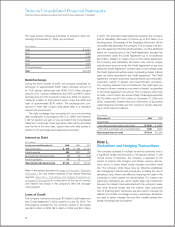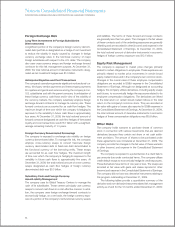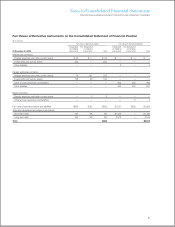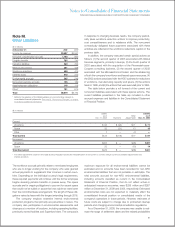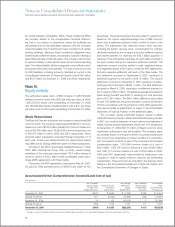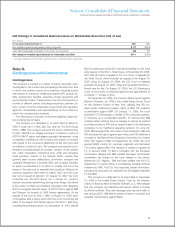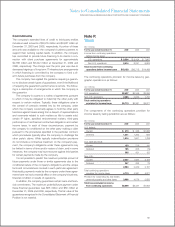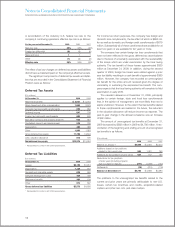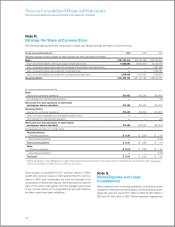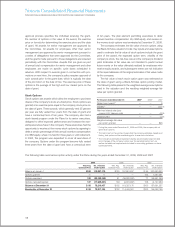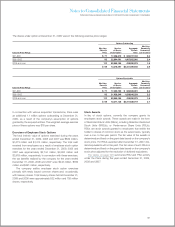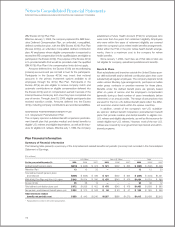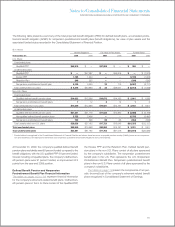IBM 2009 Annual Report Download - page 103
Download and view the complete annual report
Please find page 103 of the 2009 IBM annual report below. You can navigate through the pages in the report by either clicking on the pages listed below, or by using the keyword search tool below to find specific information within the annual report.
Notes to Consolidated Financial Statements
INTERNATIONAL BUSINESS MACHINES CORPORATION AND SUBSIDIARY COMPANIES
Commitments
The company’s extended lines of credit to third-party entities
include unused amounts of $3,576 million and $3,857 million at
December 31, 2009 and 2008, respectively. A portion of these
amounts was available to the company’s business partners to
support their working capital needs. In addition, the company
has committed to provide future financing to its clients in con-
nection with client purchase agreements for approximately
$2,788 million and $3,342 million at December 31, 2009 and
2008, respectively. The change over the prior year was due to
decreased signings of long-term IT infrastructure arrangements
in which financing is committed by the company to fund a cli-
ent’s future purchases from the company.
The company has applied the guidance requiring a guaran-
tor to disclose certain types of guarantees, even if the likelihood
of requiring the guarantor’s performance is remote. The follow-
ing is a description of arrangements in which the company is
the guarantor.
The company is a party to a variety of agreements pursuant
to which it may be obligated to indemnify the other party with
respect to certain matters. Typically, these obligations arise in
the context of contracts entered into by the company, under
which the company customarily agrees to hold the other party
harmless against losses arising from a breach of representations
and covenants related to such matters as title to assets sold,
certain IP rights, specified environmental matters, third-party
performance of nonfinancial contractual obligations and certain
income taxes. In each of these circumstances, payment by
the company is conditioned on the other party making a claim
pursuant to the procedures specified in the particular contract,
which procedures typically allow the company to challenge the
other party’s claims. While typically indemnification provisions
do not include a contractual maximum on the company’s pay-
ment, the company’s obligations under these agreements may
be limited in terms of time and/or nature of claim, and in some
instances, the company may have recourse against third parties
for certain payments made by the company.
It is not possible to predict the maximum potential amount of
future payments under these or similar agreements due to the
conditional nature of the company’s obligations and the unique
facts and circumstances involved in each particular agreement.
Historically, payments made by the company under these agree-
ments have not had a material effect on the company’s business,
financial condition or results of operations.
In addition, the company guarantees certain loans and finan-
cial commitments. The maximum potential future payment under
these financial guarantees was $85 million and $50 million at
December 31, 2009 and 2008, respectively. The fair value of the
guarantees recognized in the Consolidated Statement of Financial
Position is not material.
Note P.
Taxes
($ in millions)
For the year ended December 31: 2009 2008 2007
Income from continuing operations
before income taxes:
U.S. operations $ 9,524 $ 8,424 $ 7,667
Non-U.S. operations 8,614 8,291 6,822
Total income from continuing
operations before income taxes $18,138 $16,715 $14,489
The continuing operations provision for income taxes by geo-
graphic operations is as follows:
($ in millions)
For the year ended December 31: 2009 2008 2007
U.S. operations $2,427 $2,348 $2,280
Non-U.S. operations 2,286 2,033 1,791
Total continuing operations
provision for income taxes $4,713 $4,381 $4,071
The components of the continuing operations provision for
income taxes by taxing jurisdiction are as follows:
($ in millions)
For the year ended December 31: 2009 2008 2007
U.S. federal:
Current $ 473 $ 338 $1,085
Deferred 1,341 1,263 683
1,814 1,601 1,768
U.S. state and local:
Current 120 216 141
Deferred 185 205 (19)
305 421 122
Non-U.S.:
Current 2,347 1,927 2,105
Deferred 247 432 76
2,594 2,359 2,181
Total continuing operations
provision for income taxes 4,713 4,381 4,071
Provision for social security, real estate,
personal property and other taxes 3,986 4,076 3,832
Total taxes included in income
from continuing operations $8,699 $8,457 $7,903
101



